|
|
|
Sort Order |
|
|
|
Items / Page
|
|
|
|
|
|
|
| Srl | Item |
| 1 |
ID:
090498
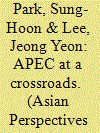

|
|
|
| 2 |
ID:
138926
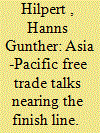

|
|
|
|
|
| Summary/Abstract |
Asia is not only the world’s most dynamic region in terms of trade, it is also an important pacesetter in trade policy. The USA is currently negotiating with 11 partner countries over a Trans-Pacific Partnership (TPP); the members of the ASEAN+6 group are in talks over a Regional Comprehensive Economic Partnership (RCEP), while Japan, China and Korea are conducting trilateral trade negotiations (China-Japan-Korea Free Trade Agreement (CJK FTA)). The multilateral structures emerging from all these initiatives could, in the long term, be combined into a Free Trade Area of the Asia-Pacific (FTAAP). What are the motives behind these agreements? What are their chances of being implemented? When it comes to the trade and geopolitical power struggle that encompasses these talks, does the USA or China have the upper hand? And what role remains for Europe’s trade policy?
|
|
|
|
|
|
|
|
|
|
|
|
|
|
|
|
| 3 |
ID:
141940
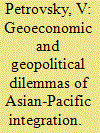

|
|
|
|
|
| Summary/Abstract |
ECONOMIC INTEGRATION in the APR has come close to fundamental qualitative changes launched by the emerging mechanisms of multi-sided integration in trade and economies. In November 2014, in Beijing the APEC summit discussed a future Free Trade Area of the Asia-Pacific (FTAAP), a Regional Comprehensive Economic Partnership (RCEP) on the basis of ASEAN and its partners, and a Trans-Pacific Partnership (TPP) lobbied by the U.S.
|
|
|
|
|
|
|
|
|
|
|
|
|
|
|
|
| 4 |
ID:
139723
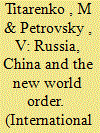

|
|
|
|
|
| Summary/Abstract |
IN RECENT YEARS, the global situation has experienced powerful shocks that have aggravated existing contradictions, fanned tensions and given rise to various threats. On the one hand, processes of mutual integration of countries remain in place and are, moreover, being speeded up by globalization, and there is a search for an optimum model of international relations based on principles of polycentrism. On the other, effects of the global financial and economic crisis are not subsiding, and in various regions - in Europe (Ukraine), in the Middle East, in Northeast Asia - there exist serious challenges to regional and global security. Time and again, unresolved old-time territorial disputes or consequences of the hegemonic policy of the United States or its allies spark conflicts.
|
|
|
|
|
|
|
|
|
|
|
|
|
|
|
|
| 5 |
ID:
146412
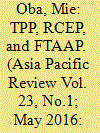

|
|
|
|
|
| Summary/Abstract |
In the Asia-Pacific region, multiple efforts to facilitate economic integration and cooperation are underway. The various frameworks come in a range of scale and scope, membership, and degree of clarity. ASEAN member countries, in a variety of combinations, are party to these trade agreements. Overlapping and multilayered, these frameworks are venues for both creating large economic areas as well as for competition for regional leadership. Besides the international dimension, the domestic situations of each participating member country affect the process of negotiations and achievement of the agreements.
|
|
|
|
|
|
|
|
|
|
|
|
|
|
|
|
|
|
|
|
|